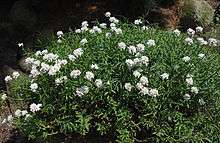Iberis
Iberis /aɪˈbɪərɪs/,[1] commonly called candytuft, is a genus of flowering plants belonging to the family Brassicaceae. It comprises annuals, evergreen perennials and subshrubs native to the Old World.[2] The name "candytuft" is not related to candy, but derives from Candia, the former name of Iraklion on the Island of Crete.[3]
| Iberis | |
|---|---|
 | |
| Perennial candytuft (Iberis sempervirens) | |
| Scientific classification | |
| Kingdom: | Plantae |
| Clade: | Tracheophytes |
| Clade: | Angiosperms |
| Clade: | Eudicots |
| Clade: | Rosids |
| Order: | Brassicales |
| Family: | Brassicaceae |
| Genus: | Iberis L. |
| Species | |
|
~30; see text | |
In the language of flowers, the candytuft symbolizes indifference.[4]
Species
Iberis consists of about 30 species of annuals, perennials and evergreen subshrubs. Some of the better known are:
Iberis amara - rocket candytuft, bitter candytuft, wild candytuft
Iberis ciliata
Iberis gibraltarica - Gibraltar candytuft
Iberis linifolia
Iberis procumbens - dune candytuft
Iberis sempervirens - evergreen candytuft, perennial candytuft
Iberis umbellata - globe candytuft
They are used as ornamental plants for rock gardens, bedding, and borders in full sun or light shade. Candytuft is a cold hardy, fast-growing annual with lance shaped green leaves. It reaches a height of about 12 in (30 cm) with a spread of about 6 in (15 cm).
Trophic connections
These plants provide nourishment for a number of insect species of which the rare Euchloe tagis butterfly is the most striking example as it is monophagous on species in this genus.
References
- Sunset Western Garden Book, 1995:606–607
- RHS A-Z encyclopedia of garden plants. United Kingdom: Dorling Kindersley. 2008. p. 1136. ISBN 1405332964.
- Shorter Oxford English dictionary, 6th ed. United Kingdom: Oxford University Press. 2007. p. 3804. ISBN 0199206872.
- "Language of Flowers - Flower Meanings, Flower Sentiments". www.languageofflowers.com. Retrieved 2016-11-26.